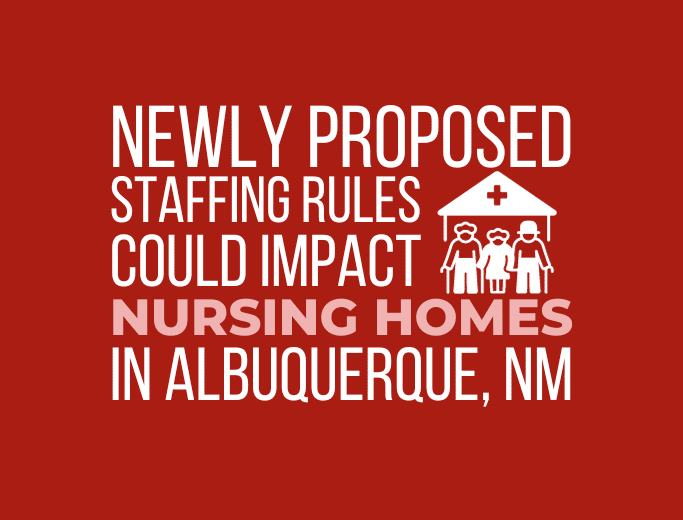Proposed Nursing Home Staffing Rules May Impact Albuquerque Nursing Homes

Throughout the country, nursing homes and care facilities continue to face chronic understaffing. This problem is especially apparent in Albuquerque and throughout New Mexico as a whole. A report from the federal government released early 2023 ranks the Land of Enchantment as one of the five worst states for staffing hours within nursing facilities. However, a federal proposal outlining stronger suggestions for nursing homes across the U.S. also released in early 2023 seeks to remedy the issue. Should the proposal move forward, it could impact a large number of nursing facilities in Albuquerque. In this article, we’ll examine the factors that contributed to the nationwide staffing shortages, what the new proposal covers, and what barriers still hinder improvement to this ongoing crisis.
Nursing Home Staffing Shortages: A Challenge Spanning Decades
Chronic understaffing in New Mexico nursing homes is far from a new problem. In 2001, the Centers for Medicare and Medicaid Services (CMS) conducted a study on the ratio of nurses to residents in nursing facilities. The results of the study unequivocally showed the correlation between staffing shortages and the level of care patients received. Once a nursing home reaches critical levels of understaffing, residents are more likely to receive a lower quality of care. In this 2001 study, it was determined that a majority of the facilities were failing to meet the thresholds necessary for optimal care of nursing home patients.
Working conditions in nursing homes became significantly more difficult at the onset of the Coronavirus outbreak in the US. At the start of the pandemic, when personal protective equipment (PPE) was difficult to come by, nursing home employees quit at higher rates than any other healthcare profession. With little protective equipment to keep themselves or their patients safe, unprecedented staffing shortages, and, in some cases, an absence of livable wages, employees began walking out of nursing homes in droves.
Today, the same concerns are still present. Low wages, long hours, challenging work, and high turnover rates were consistent concerns before the COVID-19 pandemic. Employees at nursing homes can often find better pay elsewhere, opting to work in hospitals or even turning to other professions entirely, such as retail.
Proposed Solutions to Nursing Home Challenges
Little progress has been made to solve the problems plaguing the nursing home industry. However, in September 2023, the Biden administration released recommendations and a proposal for minimum staffing standards for nursing homes. This came after a 2022 commitment to create a long-term plan for addressing the chronic staffing shortages and quality of care for nursing facility residents. The proposal, released by the Department of Health and Human Services (HHS) through the Centers for Medicare & Medicaid Services (CMS), suggested establishing federal rules for minimum staffing requirements for nursing homes as well as nurse staffing standards. Under these guidelines, nursing homes that accept Medicare and Medicaid would be required to provide each resident with at least 0.55 hours (33 minutes) of care from a registered nurse (RN) per day, as well as 2.45 hours (2 hours and 27 minutes) of care from a nurse aid per resident per day. In addition, CMS proposed a new rule requiring nursing home facilities to have a registered nurse on site 24/7. According to the report, approximately 75% of nursing homes would need to increase and improve staffing for their facilities in order to be within the standards set in the new proposal.
The proposal goes even further to examine solutions for other persistent concerns, including improving nursing home inspection processes, analyzing how taxpayer dollars are used to fund nursing homes, investing in financial incentives such as scholarships and tuition reimbursement to build the nursing workforce, improving pay for nursing home employees, and investigating inappropriate use of medication as a means to restrain or sedate residents.
CMS Nursing Home Staffing Requirements: Too Extreme, or Not Enough?
While these proposed solutions seem to be a step in the right direction, others argue the rules aren’t doing enough to protect residents in nursing home facilities, and requirements should be more robust. The CMS proposal of a combined 3 hours of minimum care per patient per day was far lower than advocates for nursing home reform hoped would come from this proposal. In contrast, the landmark 2001 study conducted by CMS recommends an average of 4.1 hours of care per resident per day. However, even that number, they argue, is low and is only the minimum amount of time necessary to reduce potential harm to residents. To provide a better quality of life for residents, this number would need to be higher. Following the release of the proposal, advocates for nursing home reform called the rules “completely inadequate,” “heartbreaking,” and “nauseating.” Those in favor of more stringent regulations of nursing homes argue that the research outlining the level of care residents need has been available for over 20 years, and implementing those changes is long overdue.
Still, others argue that the proposal as it exists is too extreme and will have unintended consequences for nursing home residents. Many nursing home facilities across the US already meet the proposal’s threshold for the minimum amount of time spent per resident per day. In an already struggling field lacking the numbers to staff their facilities adequately, nursing homes fear they will be unable to meet the employment requirements as outlined in the proposal. They point to the lingering effects of the pandemic, which has weakened the workforce, and low payments from Medicaid that would hinder their ability to pay employees. Opponents also argue that nursing homes in rural communities will bear the brunt of these proposed changes, claiming that small communities without the population to staff a nursing home adequately will potentially have to close their doors, leaving elderly and vulnerable communities without any options at all for care.
In response, the CMS proposal has outlined a staggered approach to implementing changes to account for potential barriers that rural communities may face. While urban facilities would have a two-year period to meet the requirement for having a registered nurse on staff 24/7, rural nursing homes would have three years to achieve this goal. For nurse aid minimum staffing requirements, urban nursing homes would have three years to meet their target, while rural homes would have five years. Additionally, nursing homes would be able to make an appeal if they found their facility did not have the resources to meet federal requirements. Factors such as demonstrating a “good faith effort” to meet standards would be considered in the appeals process. Finally, by providing monetary incentives to build the healthcare workforce and increasing transparency in the way for-profit nursing homes are funded, the proposal hopes to combat the issues that may arise with increased staffing requirements.
Impact on Albuquerque Nursing Homes
Should this proposal go into effect as-is, it will likely impact nursing homes throughout New Mexico. While many nursing homes throughout the U.S. already meet the combined 3 hours of care per day as outlined by CMS, New Mexico care facilities were recently found to barely meet that threshold. In the last quarter of 2022, nursing homes in New Mexico obtained an average of 3.36 hours per resident per day, or approximately 3 hours and 17 minutes. This means that New Mexico nursing facilities are only just meeting minimum standards for care under this new proposal. Additionally, under current New Mexico law, care facilities are only required to provide an average of 2.3 or 2.5 hours of care to each resident per day, depending on whether they operate as a skilled or intermediate facility. New Mexico nursing homes would likely need to significantly increase their number of employees in order to meet or exceed the new proposed requirements.
Changes on the Horizon
The CMS proposal may still be modified depending on further review and public feedback. The language has not been finalized as of October 2023, and a senior White House official stated the Biden administration was open to amending some of the conditions of the proposal, such as the staffing threshold, once the policy has been implemented.
A federal approach to regulating nursing home staffing requirements and providing better care to residents will likely come with its fair share of challenges. For years, states have largely operated under their own set of laws regarding nursing home care. Federal law currently leaves much of the decision-making power regarding nursing home staffing with the states. While increasing staffing requirements and the time spent per resident are necessary steps to improve nursing home conditions and prevent nursing home abuse and nursing home neglect, accomplishing tasks on a federal level will be a significant undertaking. Substantial work still needs to be done to ensure our loved ones in nursing homes are receiving adequate support. Any noticeable changes in the quality of care residents receive will likely take years.
Albuquerque Nursing Home Abuse Lawyers
While advocates and critics of the CMS proposal may not agree on how changes are implemented, there’s one thing both sides generally agree on: the current state of the nursing home industry is failing our elderly population. Without a clear end in sight to nursing home staffing shortages, elderly residents and loved ones in these facilities will continue to pay the price. The quality of care has already rapidly decreased within the last decade resulting in nursing home falls, and other forms of negligence, including bedsores. Without change, quality of care is expected to decrease, leaving elders at risk.
Our seniors deserve to be treated with care and respect. If you believe your loved one has been a victim of nursing home abuse or neglect, you don’t have to face this challenge alone. Look for the signs of elder abuse when visiting your loved ones in facilities, and if any seem prevalent, call us and get a Ron Bell Albuquerque nursing home abuse attorney on your side. We’ll fight for the justice your loved one deserves! Call us today at 898-BELL to speak with a caring and compassionate member of our nursing home legal team.
If you believe your loved one has been abused in a Nursing Home in Albuquerque, there are programs and services within the state that are in place to protect you and your family. Learn more by visiting New Mexico Nursing Home Abuse Resources.
If you are unsure whether your loved one has experience Nursing Home Abuse, view Nursing Home Abuse Frequently Asked Questions.
Why Choose Ron Bell Injury Lawyers?
We Get Results!
